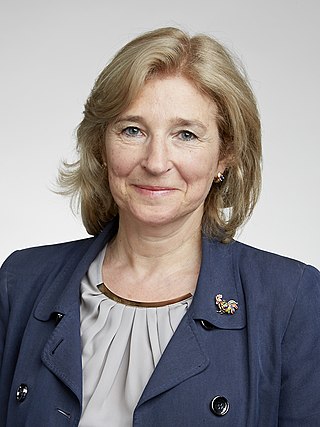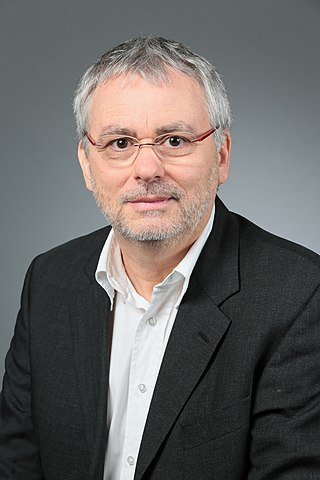Related Research Articles
Phase-shift keying (PSK) is a digital modulation process which conveys data by changing (modulating) the phase of a constant frequency carrier wave. The modulation is accomplished by varying the sine and cosine inputs at a precise time. It is widely used for wireless LANs, RFID and Bluetooth communication.
All-silica fiber, or silica-silica fiber, is an optical fiber whose core and cladding are made of silica glass. The refractive index of the core glass is higher than that of the cladding. These fibers are typically step-index fibers. The cladding of an all-silica fiber should not be confused with the polymer overcoat of the fiber.
The Journal of Lightwave Technology is a biweekly peer-reviewed scientific journal covering optical guided-wave science, technology, and engineering. It is published jointly by the Optical Society and the IEEE Photonics Society. It was established in 1983 and the editor-in-chief is Gabriella Bosco. According to the Journal Citation Reports, the journal has a 2021 impact factor of 4.439.
IEEE 802.11g-2003 or 802.11g is an amendment to the IEEE 802.11 specification that operates in the 2.4 GHz microwave band. The standard has extended link rate to up to 54 Mbit/s using the same 20 MHz bandwidth as 802.11b uses to achieve 11 Mbit/s. This specification, under the marketing name of Wi‑Fi, has been implemented all over the world. The 802.11g protocol is now Clause 19 of the published IEEE 802.11-2007 standard, and Clause 19 of the published IEEE 802.11-2012 standard.

Robert Louis Byer is a physicist. He was president of the Optical Society of America in 1994 and of the American Physical Society in 2012.
The IEEE Photonics Society, formerly the IEEE Lasers and Electro-Optics Society (LEOS), is a society of the Institute of Electrical and Electronics Engineers (IEEE), focused on the scientific and engineering knowledge about the field of quantum electronics. In the hierarchy of IEEE, the Photonics Society is one of the close to 40 technical societies organized under the IEEE Technical Activities Board.
The IEEE Photonics Award is a Technical Field Award established by the IEEE Board of Directors in 2002. This award is presented for outstanding achievements in photonics, including work relating to: light-generation, transmission, deflection, amplification and detection and the optical/electro-optical componentry and instrumentation used to accomplish these functions. Also included are storage technologies utilizing photonics to read or write data and optical display technologies. It also extends from energy generation/propagation, communications, information processing, storage and display, biomedical and medical uses of light and measurement applications.

Orbital angular momentum multiplexing is a physical layer method for multiplexing signals carried on electromagnetic waves using the orbital angular momentum (OAM) of the electromagnetic waves to distinguish between the different orthogonal signals.
A super-channel is an evolution in dense wavelength-division multiplexing (DWDM) in which multiple, coherent optical carriers are combined to create a unified channel of a higher data rate, and which is brought into service in a single operational cycle.
In physics, a high contrast grating is a single layer near-wavelength grating physical structure where the grating material has a large contrast in index of refraction with its surroundings. The term near-wavelength refers to the grating period, which has a value between one optical wavelength in the grating material and that in its surrounding materials.

Polina Leopoldovna Bayvel is a British engineer and academic. She is currently Professor of Optical Communications & Networks in the Department of Electronic and Electrical Engineering at University College London. She has made major contributions to the investigation and design of high-bandwidth multiwavelength optical networking.
Constellation shaping is an energy efficiency enhancement method for digital signal modulation that improves upon amplitude and phase-shift keying (APSK) and conventional quadrature amplitude modulation (QAM) by modifying the continuous uniform distribution of the data symbols to match the channel. In a channel corrupted by an additive white Gaussian noise (AWGN), this implies transmitting low-energy signals more frequently than high-energy signals with the target to approach a Gaussian distribution of the transmission power.
Frank Effenberger is an American electrical engineer. He is currently Vice President and Fellow of Fixed Access Networks at FutureWei Technologies.
Jason P Jue is a professor of computer science and the director of the Advanced Networks Research Lab at the University of Texas at Dallas.
Ashwin Gumaste is an Indian computer engineer and institute chair professor at the department of computer science and engineering of the Indian Institute of Technology, Bombay. He is known for his work on Carrier Ethernet Switch routers—the largest technology transfer between any IIT and industry.

Martin D. Dawson is a British professor of photonics who is research director of the Institute of Photonics at the University of Strathclyde and is Head of Fraunhofer Centre for Applied Photonics. He has made pioneering contributions in several applied photonics areas.

Keren Bergman is an American electrical engineer who is the Charles Batchelor Professor at Columbia University. She also serves as the director of the Lightwave Research Laboratory, a silicon photonics research group at Columbia University. Her research focuses on nano-photonics and particularly optical interconnects for low power, high bandwidth computing applications.
Peter J. Delfyett Jr is an American engineer and Pegasus Professor and Trustee Chair Professor of Optics, ECE & Physics at the University of Central Florida College of Optics and Photonics.

Luc Thévenaz is a Swiss physicist who specializes in fibre optics. He is a professor of physics at EPFL and the head of the Group for Fibre Optics School of Engineering.
Boon S. Ooi is a Malaysian–American academic researcher and a Professor of Electrical and Computer Engineering at King Abdullah University of Science and Technology (KAUST) in Saudi Arabia. He was faculty member at Nanyang Technological University (Singapore) from 1996 to 2000 and at Lehigh University from 2003 to 2009. He served as Director of KACST-Technology Innovation Center at KAUST from 2012 to 2020.
References
- ↑ "Gabriella Bosco". ieee-jlt.org. Retrieved 2020-06-28.
- ↑ Bosco, Gabriella (2019-01-01). "Advanced Modulation Techniques for Flexible Optical Transceivers: The Rate/Reach Tradeoff". Journal of Lightwave Technology. 37 (1): 36–49. Bibcode:2019JLwT...37...36B. doi:10.1109/JLT.2018.2886257. ISSN 1558-2213. S2CID 59601685.
- ↑ "Author Page: Gabriella Bosco". IEEE . Retrieved 2020-06-30.
- ↑ "Gabriella Bosco | OptCom". www.optcom.polito.it. Retrieved 2020-06-30.
- ↑ "Autori Aracne editrice - Gabriella Bosco". www.aracneeditrice.it. Retrieved 2020-06-30.
- ↑ "Gabriella Bosco - Google Scholar Citations". scholar.google.com. Retrieved 2020-06-28.
- ↑ "IEEE JLT - Editorial Board". ieee-jlt.org. Retrieved 2020-06-28.
- ↑ "Best Paper Awards". IEEE Journal of Lightwave Technologies. Retrieved 2020-06-30.
- ↑ Bosco, G; Curri, V; Carena, A; Poggiolini, P; Forghieri, F (1 January 2011). "On the Performance of Nyquist-WDM Terabit Superchannels Based on PM-BPSK, PM-QPSK, PM-8QAM or PM-16QAM Subcarriers". Journal of Lightwave Technology. 29 (1): 53–61. Bibcode:2011JLwT...29...53B. doi:10.1109/JLT.2010.2091254. ISSN 0733-8724. S2CID 29073948.
- ↑ Carena, A.; Curri, V.; Bosco, G.; Poggiolini, P.; Forghieri, F. (15 May 2012). "Modeling of the Impact of Nonlinear Propagation Effects in Uncompensated Optical Coherent Transmission Links". Journal of Lightwave Technology. 30 (10): 1524–1539. Bibcode:2012JLwT...30.1524C. doi:10.1109/JLT.2012.2189198. ISSN 0733-8724. S2CID 12909504.
- ↑ "The Optical Society Announces 2017 Fellows Class". The Optical Society of America. Retrieved 2020-06-30.
- ↑ "2019 Fellow Newly Elevated Fellows" (PDF). IEEE. Archived from the original (PDF) on December 20, 2018. Retrieved 2020-06-30.